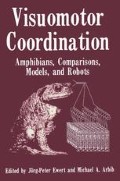Abstract
Chemical stimulation of a site on the skin of the back anterior to the iliosacral joint in high spinal frogs usually elicits a rostral wiping reflex, in which the tip of the hindlimb rubs against the site; stimulation of a site near the anus elicits a caudal wiping reflex in which the heel or side of the foot rubs against the site. The spinal frog also generates (i) a sequence of rostral-caudal wiping reflexes in response to stimulation of a site in the transition zone located between the rostral wiping receptive field (RF) and the caudal RF and (ii) a lateral wiping reflex to stimulation of a site on a side of the body. Rostral, caudal ipsilateral, and caudal contralateral wiping forms can be executed in a variable sequence to stimulation of a site in the transition zone. The map of the RFs of various wiping forms depends on the level of spinal cord transection. At a low level of transection the rostral RF can disappear, whereas the transition zone between the two RFs becomes a pure RF for a caudal wiping form. In rare cases, both intact and high spinal frogs generate an ineffective hybrid wiping reflex to stimulation of a site in the transition zone: the hindlimb then takes a conflict configuration in which the distal joints behave as in a rostral wiping, whereas the proximal joints do as in a caudal wiping. This conflict is solved by the spinal cord: after a time delay, it re-organizes the hindlimb and performs a pure wiping reflex. Thus, the spinal cord has the adaptive ability to correct occasional errors without descending neural inputs from supraspinal structures. Various aspects of the sensorimotor parallel-hierarchical organization of the wiping reflex are discussed.
Access this chapter
Tax calculation will be finalised at checkout
Purchases are for personal use only
Preview
Unable to display preview. Download preview PDF.
References
Akert K (1949) Der visuelle Greifreflex. HelvPhysiol Pharmacol Acta 7: 112–134
Arbib MA (1972) The methaphorical brain. An introduction to cybernetics as artificial intelligence and brain theory. Wiley-Interscience, New York London Toronto
Baglioni S (1913) Die Hautreflexe der Amphibien (Frosch und Kröte). Erg Physiol l3: 454–546
Berkinblit MB, Feldman AG, Fukson OI (1986a) Adaptability of innate motor patterns and motor control mechanisms. BehavBrain Sci 9: 585–599
Berkinblit MB, Gelfand IM, Feldman AG (1986b) A model for the aiming phase of the wiping reflex. In: Grillner S, Stein PSG, Stuart H, Forssberg H, Herman RM (eds) Neurobiology of vertebrate locomotion. Wener-Gren International Symposium Series Vol 45. MacMillan Press, Houndsmills Basingstoke Hampshire London, pp 217–227
Bernstein NA (1967) The co-ordination and regulation of movements Pergamon Press, Oxford
Davis MR, Constantine-Paton M (1983) Hyperplasia in the spinal sensory system of the frog. II: Central and peripheral connectivity patterns. J Comp Neurol 221: 453–465
Davis WJ (1977) The command neuron. In: Hoyle G (ed) Identified neurons and arthropod behavior. Plenum Press, New York, pp 293–305
Ewert J-P (1987) Neuroethology of releasing mechanisms: prey-catching in toads. Behav Brain Sci 10: 337405
Fentress JC (1987) Compartments and cohesions in adaptive behavior. J Comp Psychol 101: 254–258
Friesen WO, Stent GS (1978) Neuronal circuits for generating rhythmic movements. Ann Rev Biophys Bioengin 7: 37–61
Fuchs AF, Kaneko C (1985) A brain stem generator for saccadic eye movements. In: Evarts EV, Wise SP, Bousfield D (eds) The motor system in neurobiology. Elsevier Biomedial Press, Amsterdam New York Oxford, pp 126–132
Grillner S (1981) Control of locomotion in bipeds, tetrapods, and fish. In: Brooks V (ed) Handbook of physiology, Section 1, The nervous system, Part 2. American Physiol Society, Bethesda, pp 1179–1236 Hinton GE (1984) Parallel computations for controlling an arm. J Mot Behavl6: 171–194
Ingle D (1968) Visual releasers of prey-catching behavior in frogs and toads. Brain BehavEvol 1: 500–518 Kupfermann J, Weiss RW (1978) The command neuron concept. Behav Brain Sci 1: 3–39
McClelland JL, Rumelhart DE, Hinton GE (1986) The appeal of parallel distributed processing. In: Rumelhart DE, McClelland JL (eds) Parallel distributed processing: explorations in the microstructure of cognition, Vol 2. MIT Press, Cambridge Mass, London, pp 3–44
Mortin LI, Keifer J, Stein PSG (1985) Three forms of the scratch reflex in the spinal turtle: Movement analyses. J Neurophysiol53: 1501–1516
Robertson GA, Mortin LI, Keifer J, Stein PSG (1985) Three forms of the scratch reflex in the spinal turtle: Central generation of motor pattern. JNeurophysiol53: 1517–1534
Simpson JJ (1976) Functional synaptology of the spinal cord. In: Llinas R, Precht W (eds) Frog neurobiology. Springer-Verlag, Berlin Heidelberg New York, pp 728–749
Stein PSG (1983) The vertebrate scratch reflex. Symp Soc Exp Biol37: 383–403
Stein PSG, Camp AW, Robertson GA, Mortin LI (1986) Blends of rostral and caudal scratch reflex motor patterns elicited by stimulation of two sites in the spinal turtle. JNeurosci 6: 2259–2266
Viviani P, Terzuolo C (1982) Trajectory determines movement dynamics. Neunosci 7: 431–437
Author information
Authors and Affiliations
Editor information
Editors and Affiliations
Rights and permissions
Copyright information
© 1989 Springer Science+Business Media New York
About this chapter
Cite this chapter
Berkinblit, M.B., Feldman, A.G., Fukson, O.I. (1989). Wiping Reflex in the Frog: Movement Patterns, Receptive Fields, and Blends. In: Ewert, JP., Arbib, M.A. (eds) Visuomotor Coordination. Springer, Boston, MA. https://doi.org/10.1007/978-1-4899-0897-1_20
Download citation
DOI: https://doi.org/10.1007/978-1-4899-0897-1_20
Publisher Name: Springer, Boston, MA
Print ISBN: 978-1-4899-0899-5
Online ISBN: 978-1-4899-0897-1
eBook Packages: Springer Book Archive

